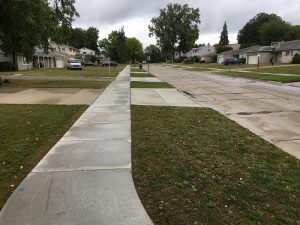There are a variety of unintended consequences when communities pay little attention to the walkability and bikeability of their community – many of which fall in the realm of public health and safety. For instance, when a community is designed without active living in mind, rates of diseases associated with a lack of physical activity skyrocket, and residents who chose to walk and bike can be forced into dangerous circumstances in order to be active.

In an effort to confront these challenges head on, the City of Southfield decided to pursue Safe Routes to School (SRTS) funding and successfully completed the infrastructure portions of their SRTS project in 2018. This work takes time and was the result of work that began back in 2014 when leaders for the City of Southfield, along with the City of Oak Park and the Road Commission for Oakland County started looking for ways to improve public health. Upon studying the routes children were frequently taking to three local public and private schools, Thompson International Academy, Yeshiva Beth Yehudah, and Beth Jacob School, significant issues were revealed. Along the major roads children were using to get to school, they found sidewalks were often unavailable. This forced children to walk in the streets. Just as concerning, when officials engaged in the SRTS standard walking audit process, they found students were dashing across busy, high-speed intersections, which was dangerous.
The first solution was to add new sidewalks, fill in gaps in the existing sidewalk network, and add ADA-accessible ramps wherever appropriate. The crown jewels of the project were two pedestrian refuge islands: one at the corner of 10 Mile Road west of Fairfax and the other at 11 Mile and Fairfield Road. The latter included an advanced HAWK (High-Intensity Activated CrossWalK) beacon system that allows users to press a signal button cueing a red light to regulate the traffic at the crossing. Developed in the 90s, the HAWK makes it easier and safer for people to cross busy streets while maintaining the integrity of a 5-lane, high-speed road when pedestrian users are not present, making it effective for motorists as well.

Local business owners have approached the City of Southfield about putting in similar pedestrian features near their locations, and that is an indicator of the project’s success. City Engineer for the City of Southfield Leigh Schultz remarked, “I think it’s been well received, and we’ve already changed opinions.”
Project Impact:
Southfield’s new infrastructure, particularly the construction of two pedestrian refuge islands, has greatly increased safety for students that walk, bike, and roll to school. While this has primarily benefited school children, it has impacted the community at large, including the growing Orthodox Jewish community who adhere to the 39 Melachot of Shabbat, when just before sundown on Fridays until just after sundown on Saturday many activities are prohibited as it is a time of rest. This includes no driving, cycling, or using public transit, which means everyone walks, and having safe routes, especially to and from synagogue, is a necessity. Overall, this project has increased safety, improved community health and wellness, honored traditional beliefs and practices, and contributed to a better quality of life.
- MDOT Infrastructure Investment: $600,000.00
- MDOT Non-infrastructure Investment: $23,992.50
- City of Southfield Investment: $102,827.00
This project was made possible through the collaborative efforts of the City of Southfield, City of Oak Park, Road Commission of Oakland County, Thompson International Academy of Southfield Public School District, Beth Jacob School, Yeshiva Beth Yehudah, Michigan Fitness Foundation, Michigan Department of Transportation, and the Federal Highway Administration.
